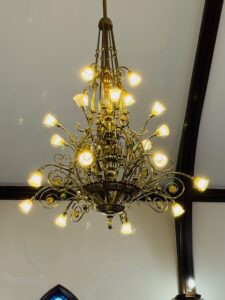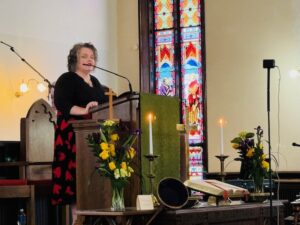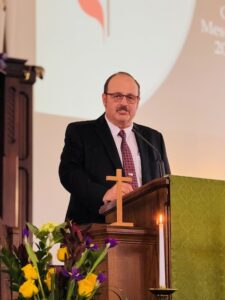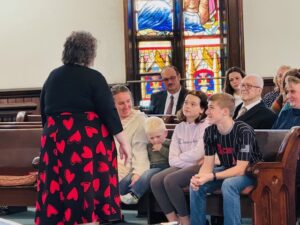By Sheri Trusty, Seneca County Media Relations Coordinator
In 1824, the year that Seneca County was founded, a group of local residents formed St. Paul’s Methodist Episcopal Church in Tiffin, making it the first Protestant congregation formally organized in Seneca County. On Sunday, Nov. 3, the church – now called Tiffin St. Paul’s United Methodist Church (UMC) – celebrated the 200th anniversary of its congregation. Throughout its 200 years, the church experienced an eclectic history, from its beginnings in a building that also housed a jail to its famous chandelier that was personally donated by Thomas Edison.


The anniversary worship service was attended by many local dignitaries, including Seneca County Commissioner Bill Frankart; his wife, Janet Frankart; and their daughter, Kayla Frankart.


“Sunday was a great day to celebrate St Paul’s 200th anniversary as the amazing chandelier illuminated the church,” Commissioner Frankart said. “As incredible as the chandelier is, the true testament of the church is the congregation that persevered for many generations, with many more to come.”
When St. Paul’s was founded in 1824, the congregation met in the Hedges building, a multicomplex structure which also housed a jail. The building’s courtroom was utilized for legal proceedings during the week and for church services on Sundays.
“When third graders visit our church, they love to hear that the congregation met in a building that also housed a jail in the basement, a store and a gathering place like a bar,” said Pastor Charlene Thomas. “The congregation met in the Hedges building for several years until they outgrew it.”
Construction on the church’s third and current building began in 1873, but the building plans were delayed by what Thomas believes was divine serendipity.


“They got the frame up and completed the ground floor, which is now our fellowship hall,” Thomas said. “They worshipped on the ground floor and had to stay there until 1883. I say that was a God thing. Had things gone according to plan, we would have missed the opportunity to receive the Edison chandelier.”
Edison patented a lightbulb in 1879 and patented an improved, longer-lasting version in 1880. When construction on St. Paul’s continued in 1883, electricity had become a revolutionary but viable source of light.
“When the building was constructed, some quick-thinking contractors wired the church for electricity, so Edison donated the chandelier to us,” Thomas said. “We became the first church in the country to be wired for electricity while being built.”
Today, the chandelier still illuminates the church’s place in national history. St. Paul’s is on the National Register of Historic Places and the Register of United Methodist Historic Sites.


“We continue to use the chandelier to shine light on our worship services and celebrations,” Thomas said. “It’s neat to think of all the people who prayed under that light, all the work done, all the celebrations, and even the somber times.”
The chandelier is symbolic, and yet tangible, evidence of the church’s mission to shine light into the community. In its earliest days, the church shared space with a jail, a courtroom and a bar. Today, it willingly shares its space with many local organizations, including a martial arts class, Impact Youth Center, and the Community on Stage summer arts academy. The church has hosted the Sharing Kitchen since the 1980s, and Thomas estimates that the kitchen has fed 175,000 people in that time.
“We want to feed and teach people. That’s the DNA of the church,” Thomas said. “Churches sit empty 90% of the week. We don’t believe that’s God’s intention for it. We really believe God gave us this place and these people as a resource for the community, and we want to be a community anchor.”
